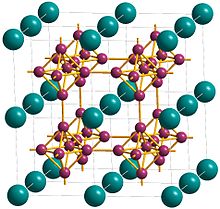 | |
| Names | |
|---|---|
| Other names Praseodymium boride | |
| Identifiers | |
3D model (JSmol) | |
| ChemSpider | |
| ECHA InfoCard | 100.031.382 |
| EC Number |
|
PubChem CID | |
CompTox Dashboard (EPA) | |
| |
| |
| Properties | |
| PrB6 | |
| Molar mass | 205.77 g/mol |
| Appearance | black crystals |
| Density | 4.84 g/cm3 |
| Melting point | 2610 °C [1] |
| Structure | |
| Cubic | |
| Pm3m ; Oh | |
Except where otherwise noted, data are given for materials in their standard state (at 25 °C [77 °F], 100 kPa). | |
Praseodymium hexaboride is a binary inorganic compound of praseodymium and boron with the formula PrB6. It forms black crystals that are insoluble in water.